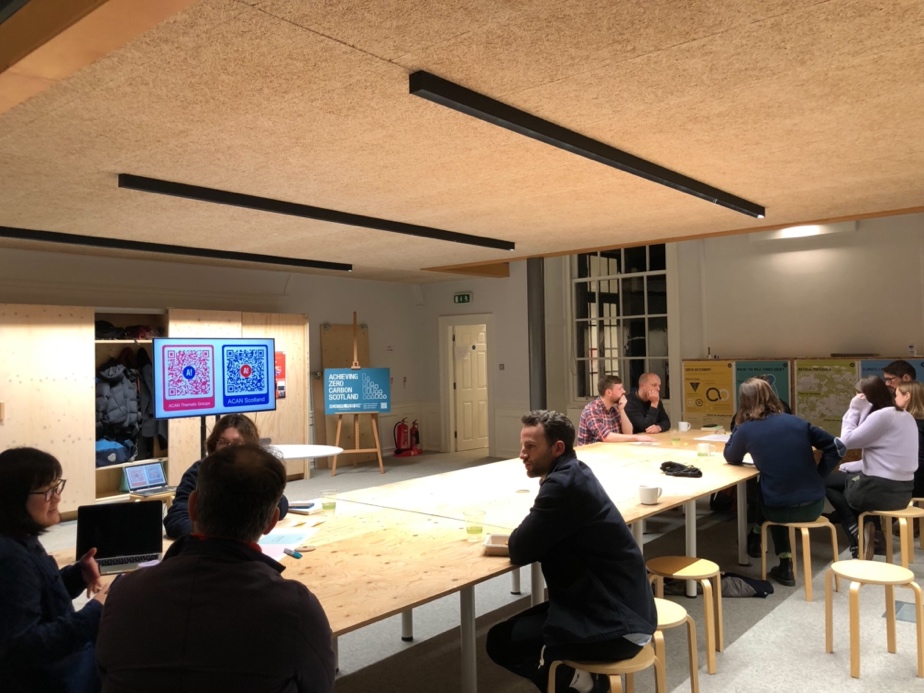Architype enjoyed welcoming the Architect Climate Action Network’s Climate Literacy Group and Architects Declare into our Edinburgh studio to host the Scottish half of the culmination of their collaborative, complementary events series: ACAN’s Climate Conversations and AD’s Masterclasses. These explore the practicalities of transforming architectural practice during a climate and ecological emergency.
The event was in two parts: the first half being a series of updates that was live streamed between our studio in Edinburgh, Pollard Thomas Edward’s office in London, and for an online audience. The second half was participatory and involved invited guests in each location and online, hosting world café styled discussions around different themes with an emphasis placed on collaboration beyond industry and practice.
Themes explored in Edinburgh were:
A Just Transition – facilitated by Stuart Graham from the Glasgow Trade Union CongressDegrowth – facilitated by Sandy Halliday of Gaia ResearchCulture – facilitated by Kam Chan of the Architecture FringeCircular Economy – facilitated by Tamsie Thomson (RIAS), Jo McClelland (EAA and EALA Impacts) and Ben Rainger (RIAS Sustainability Working Group)
Culture – a session involving Architype’s architect, Alex Reeves
The Culture World Cafe discussion focused around 2023’s Architecture Fringe provocation of (Re)evolution!,and specifically whether a new Hippocratic Oath was required in architecture. Discussion focused on how this could be framed to address imbalance between the global north/south divide and include voices excluded from dominant professional discourses. Ideas included developing a non-verbal oath which could be communicated without barriers of language.
Discussion also included debate on the challenges of ‘doing no harm’ in a profession deeply embedded in the extractive non-circular economic model. This drew on parallels to the medical profession, where the core principle of ‘do no harm’ appears focused on patient care and does not always seem to include the wider professional context – e.g., big pharma, health demographics, healthcare insurance etc.
Circular Economy – a session involving Architype’s architectural assistant, Sean McQueenie
The circular economy roundtable discussion centred around how architects, designers, and constructors could operate with more accountability and emphasis on the broader, less commonly understood impacts of design, specification and building life cycles and their associated impacts. A key suggestion was for the development and implementation of holistic changes to Construction Design Management (CDM) Regulations, with the
addition of an urgent key focus: ‘Removal’ (CDM-R); addressing the lack of whole life considerations enforced in current building design.
These themes were distilled into several topics under a meta theme of
context(s):
Accessibility, Knowledge and Understanding
Those who work on existing buildings are already practicing circular economy and de-growth principles, from the re-use (up-, re-, and down-cycling of materials and objects) to understanding whole life cycles, such as designing buildings for future adaptations in use, combined with serious consideration of the ease of disassembly and re-use, with limitations placed on ‘sticky’ buildings – materials that are glued or bound together in a manner which is difficult to adapt, edit or re-use efficiently
Quality and Empathy
A concept of radical design through the prism of being rigorously respectful of (social, economic, and physical) contexts and existing craft and detail, constructed by skilled people who are willing to pass on this knowledge to empower the community to manifest positive change.Economy with a focus on value over profit
To restore value in the architectural profession, architects must learn to add value to the areas in which they operate (not merely in terms of profit). Architecture must be a proactive industry in anticipation of long-term future needs with a clarity of purpose (rather than a reaction to political or artistic movements and fads).
Management
Better management of public buildings and social housing and spaces, with more checks in place to hold landlords to account throughout a building’s lifecycle, while increasing potential for community ownership. A handover manual with the specifications of materials used to prevent inappropriate repair. Building components should therefore be more modular (i.e., promoting the ability for homeowners to repair single tiles of glazing, rather than whole units) to reduce wasted costs, materials and skills and there should be an onus on architects to conduct longer term handover assessments.
Into the Future
To close the evening, an open space was held for local callouts for collaboration and support, and three were heard from the Edinburgh Community Climate Forum, the Scottish Communities Climate Action Network from the coordinator of its Edinburgh Climate Action Network, and South of Scotland Community Housing.
For an evening, Edinburgh’s Old Assembly Rooms, and Architype’s youngest studio, was animated by the energy of people coming together – from architects and engineers to activists, artists, and trade unionists – to discuss not just the negative impacts of construction and the scale of the problem we face, but the opportunities and possibilities created by placing principles of climate justice, circularity and degrowth, at the heart of a just transition for society which will require collective action.
It also embodied living up to our own Architects Declare commitment: putting 3 of the 12 AD Principles – to Raise Awareness, to Share Knowledge, and to Collaborate and Reduce, into action. May it be the first of many such occasions, and may it inspire others to open their own doors: to host collectives who are not only reimagining architecture and construction for a decarbonised future – where fuel poverty is a thing of the past – but are taking the kind of action needed to get us there.


